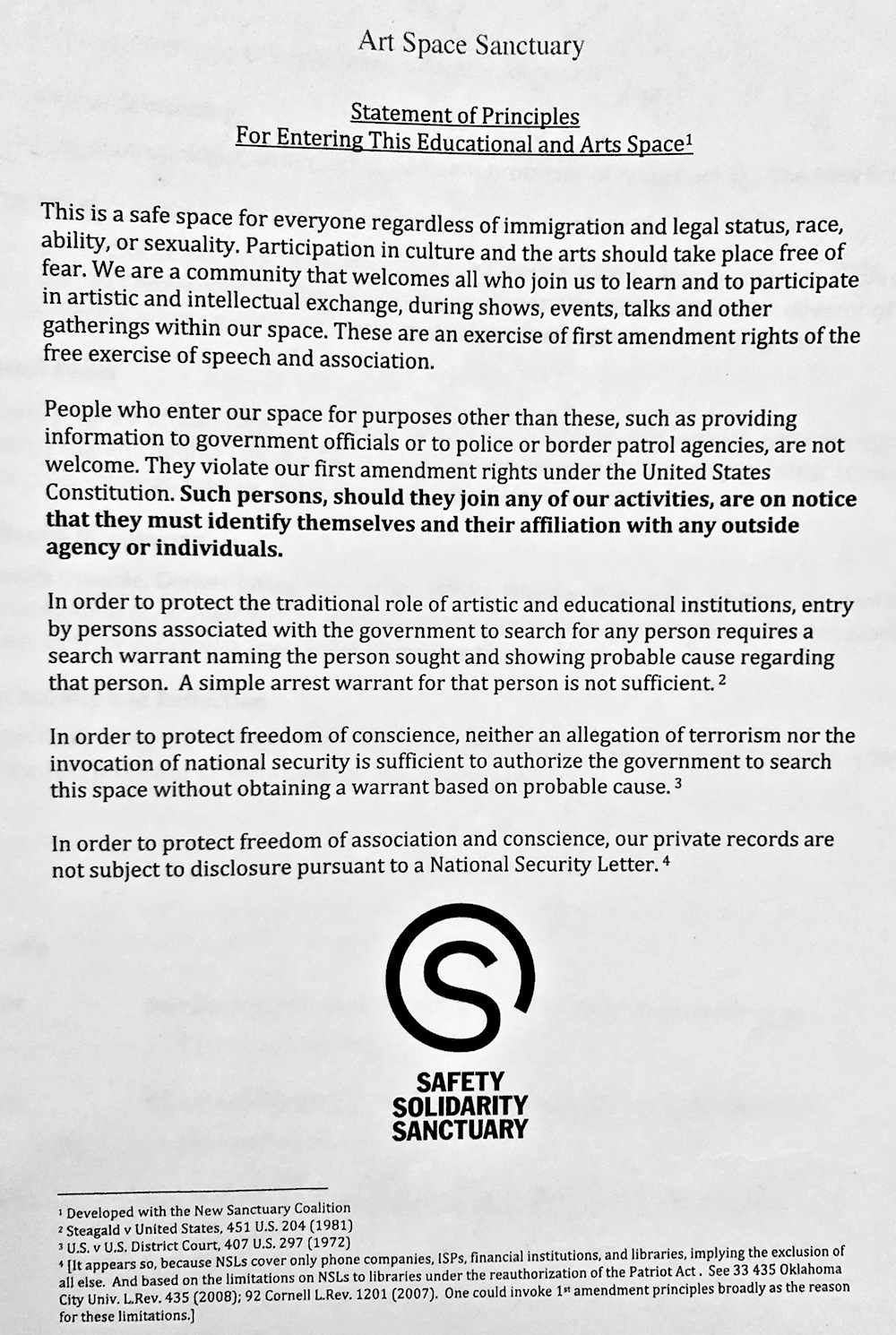A reexamination of the “safe space”: enacting radical notions of sanctuary in art, and a closer look at the roles of divestment and decolonization
In the underground or Do-It-Yourself/DIY realm of the arts community I came up in, the idea of a “safe space” has always been the ultimate desire, though hardly ever the resulting outcome. In the dozens of DIY art spaces I’ve organized in and performed and witnessed art in, the desire for a place that is all ages/all humans welcome, is physically and economically accessible, and is a space free from harassment and intimidation (a whole concept I will refer to from here on as a “total autonomous zone”) was the end goal. The creation of a total autonomous zone was, ideally, the creation of “safe space.” But in Denver in 2019, like many cities our size, we’re experiencing change from many angles, from our built environments being completely torn down and discarded, to our own personal, semi-private surroundings/housing situations/gathering places/art spaces evaporating right out from under our feet; the whims of the real estate market and the people with the money and ownership of the land become the ultimate determinants of who gets to hold onto any semblance of a “safe space,” whether that is an affordable art space or a home.
Sunday’s pre-conference Code Switching: The making of home with immigrant artists cracked this idea of a “safe space” wide open for me, completely turning on its head everything I thought I knew about what it means to create that ideal total autonomous zone. Abou Farman’s deep, concise look at our role as brokers of space devoted to art being safe from the brutality of the current incarnation of the U.S. as a security state (most prominently expressed through the ICE’s terrorism) had me thinking very differently about “safe spaces.” Even if the places that art is created, showcased and supported are momentary total autonomous zones, are they also sanctuaries? Do the folks who operate, curate and participate in these spaces have a beyond surface level commitment to keeping the humans who enter its doors safe from the violation of first amendment rights?
I’ve seen plenty of “all are welcome here” stickers and posters in the windows and doors of well-meaning, socially conscious art spaces; but if ICE were to appear at the door of an arts venue, are those of us who have assumed responsibility of the space trained and committed to putting our own bodies on the line? Do we have a plan to keep border patrol agents and other law enforcement from violating the rights and bodies of our fellow artists, art supporters and arts organizers?
With Farman’s presentation and conversation, there were implementable solutions that I myself as an arts organizer immediately took to heart: utilize existing laws that protect private spaces and gatherings; refuse to cooperate with law enforcement; define your space as a place of solidarity and sanctuary; in addition to signage, use your art space to host “know your rights” trainings for your community; provide accompaniment to community members with “precarious” status, and more. The most useful and immediately adaptable solution, for me, was the idea of accompaniment in many forms. The idea of connecting with members of my community who may exist with a precarious status – and offer to support and advocate for them (but only if they request it) in stressful situations. It can be accompaniment to meet with a lawyer, or as simple as going with them to run errands or tasks when they are feeling unsafe or targeted.
Farman covered so many more sides to this conversation involving artists with varying/vulnerable/precarious statuses. To bring the conversation around to grant funding and other mechanisms of finance in the arts, he connected the threat of state-sponsored terrorism through ICE with the foundations, museums, and educational institutions with board members who have made their money from private prisons, chemical weapons manufacturing, fossil fuel extraction, and more. Farman laid bare the notion that these institutions “have become the laundromats of dirty money,” referencing recent shake-ups at MoMA and the Whitney, which have seen board members’ exits (or ousters) and subsequent demands for divestment, after rightful pressure from artists, educators, social justice coalitions, directly impacted community members and other community groups.
Decolonizing every facet of the art world many of us call home is going to take a long time, but it will take even longer if those of us in positions of privilege refuse to look at the roles we play alongside our collaborators and comrades in our communities with precarious legal status. It isn’t as simple as declaring our art spaces a “sanctuary.” It requires putting our bodies on the line, demanding divestment from dirty money, accountability from arts institutions, and not accepting the idea that our art and art spaces have to be connected, controlled, or funded with a connection to state-enacted terrorism.

